First Peoples Health and Practice: Self-Determination Policy Analysis
VerifiedAdded on 2022/10/19
|8
|1678
|389
Report
AI Summary
This report critically analyzes the Right to Self-Determination policy in the context of First Peoples' health, drawing upon historical factors such as colonization and its negative impacts on health outcomes. It examines the policy's key themes, including community decision-making, decision-making organizations, and community-directed leadership, and its relevance to contemporary society. The report highlights the importance of the Universal Declaration of Human Rights in ensuring equitable healthcare for First Peoples, emphasizing the need for culturally safe and competent healthcare professionals. It discusses the significance of therapeutic relationships and the role of self-determination in promoting patient autonomy and improved health outcomes. The report emphasizes the interconnectedness of cultural, spiritual, emotional, social, and physical determinants of well-being for First Peoples and highlights the need to eliminate social exclusion, marginalization, and systemic racism in healthcare practices. It also discusses the implementation of self-determination rights and ensures the healthcare workforce is culturally safe and competent, and is able to meet the needs and preferences of the First people, thus allowing all of them to live a healthier life, free from any illness.
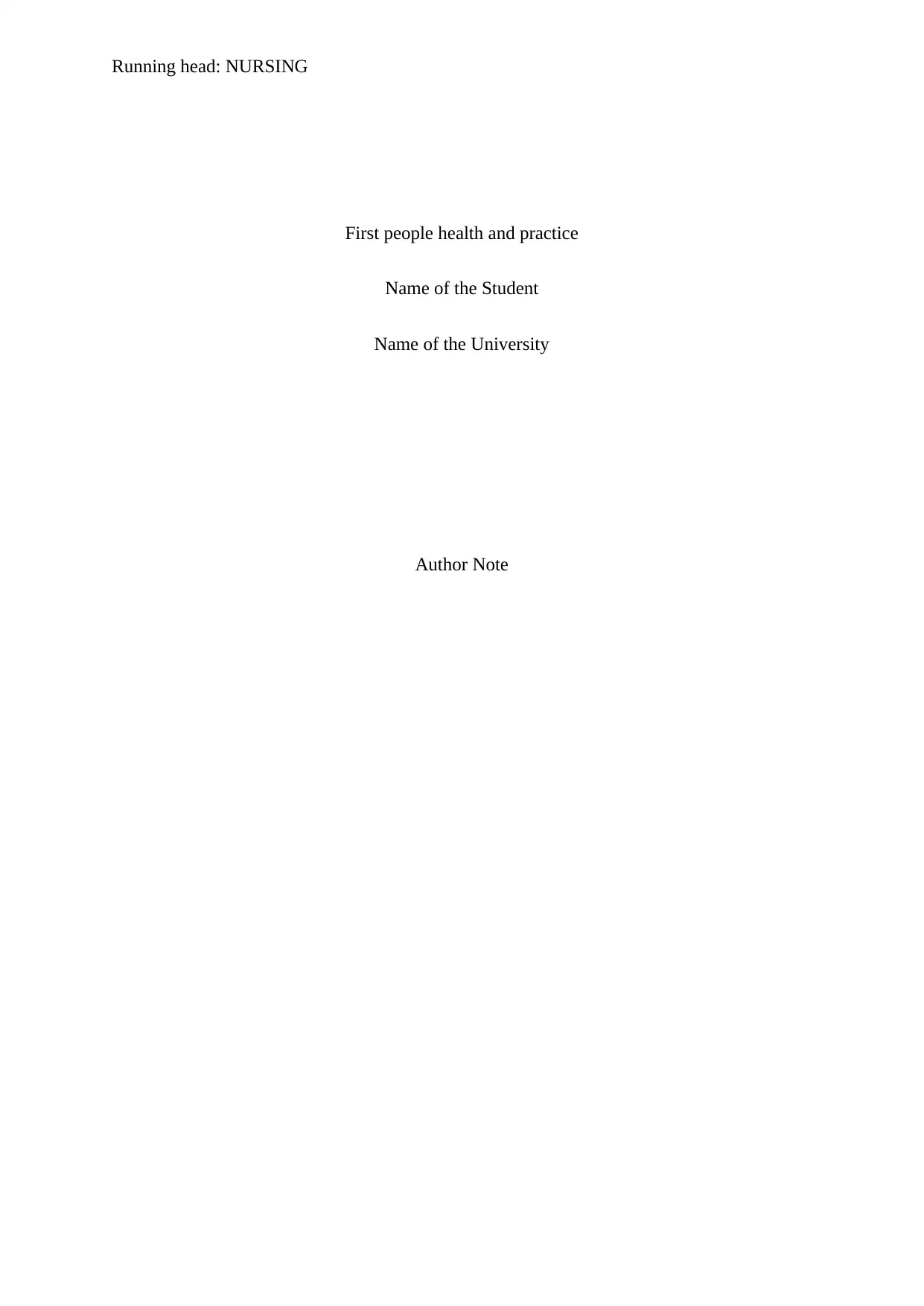
Running head: NURSING
First people health and practice
Name of the Student
Name of the University
Author Note
First people health and practice
Name of the Student
Name of the University
Author Note
Paraphrase This Document
Need a fresh take? Get an instant paraphrase of this document with our AI Paraphraser
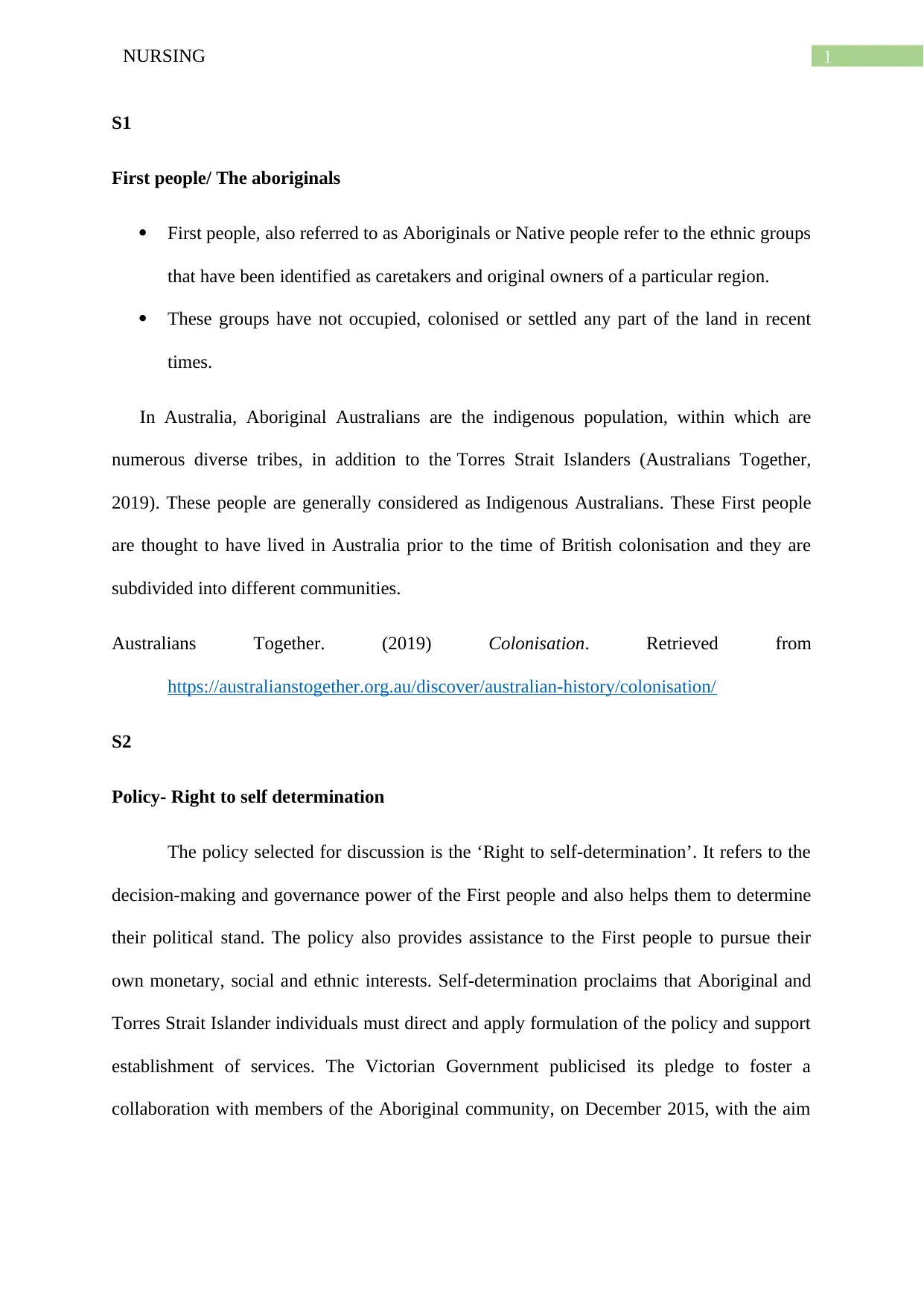
1NURSING
S1
First people/ The aboriginals
First people, also referred to as Aboriginals or Native people refer to the ethnic groups
that have been identified as caretakers and original owners of a particular region.
These groups have not occupied, colonised or settled any part of the land in recent
times.
In Australia, Aboriginal Australians are the indigenous population, within which are
numerous diverse tribes, in addition to the Torres Strait Islanders (Australians Together,
2019). These people are generally considered as Indigenous Australians. These First people
are thought to have lived in Australia prior to the time of British colonisation and they are
subdivided into different communities.
Australians Together. (2019) Colonisation. Retrieved from
https://australianstogether.org.au/discover/australian-history/colonisation/
S2
Policy- Right to self determination
The policy selected for discussion is the ‘Right to self-determination’. It refers to the
decision-making and governance power of the First people and also helps them to determine
their political stand. The policy also provides assistance to the First people to pursue their
own monetary, social and ethnic interests. Self-determination proclaims that Aboriginal and
Torres Strait Islander individuals must direct and apply formulation of the policy and support
establishment of services. The Victorian Government publicised its pledge to foster a
collaboration with members of the Aboriginal community, on December 2015, with the aim
S1
First people/ The aboriginals
First people, also referred to as Aboriginals or Native people refer to the ethnic groups
that have been identified as caretakers and original owners of a particular region.
These groups have not occupied, colonised or settled any part of the land in recent
times.
In Australia, Aboriginal Australians are the indigenous population, within which are
numerous diverse tribes, in addition to the Torres Strait Islanders (Australians Together,
2019). These people are generally considered as Indigenous Australians. These First people
are thought to have lived in Australia prior to the time of British colonisation and they are
subdivided into different communities.
Australians Together. (2019) Colonisation. Retrieved from
https://australianstogether.org.au/discover/australian-history/colonisation/
S2
Policy- Right to self determination
The policy selected for discussion is the ‘Right to self-determination’. It refers to the
decision-making and governance power of the First people and also helps them to determine
their political stand. The policy also provides assistance to the First people to pursue their
own monetary, social and ethnic interests. Self-determination proclaims that Aboriginal and
Torres Strait Islander individuals must direct and apply formulation of the policy and support
establishment of services. The Victorian Government publicised its pledge to foster a
collaboration with members of the Aboriginal community, on December 2015, with the aim
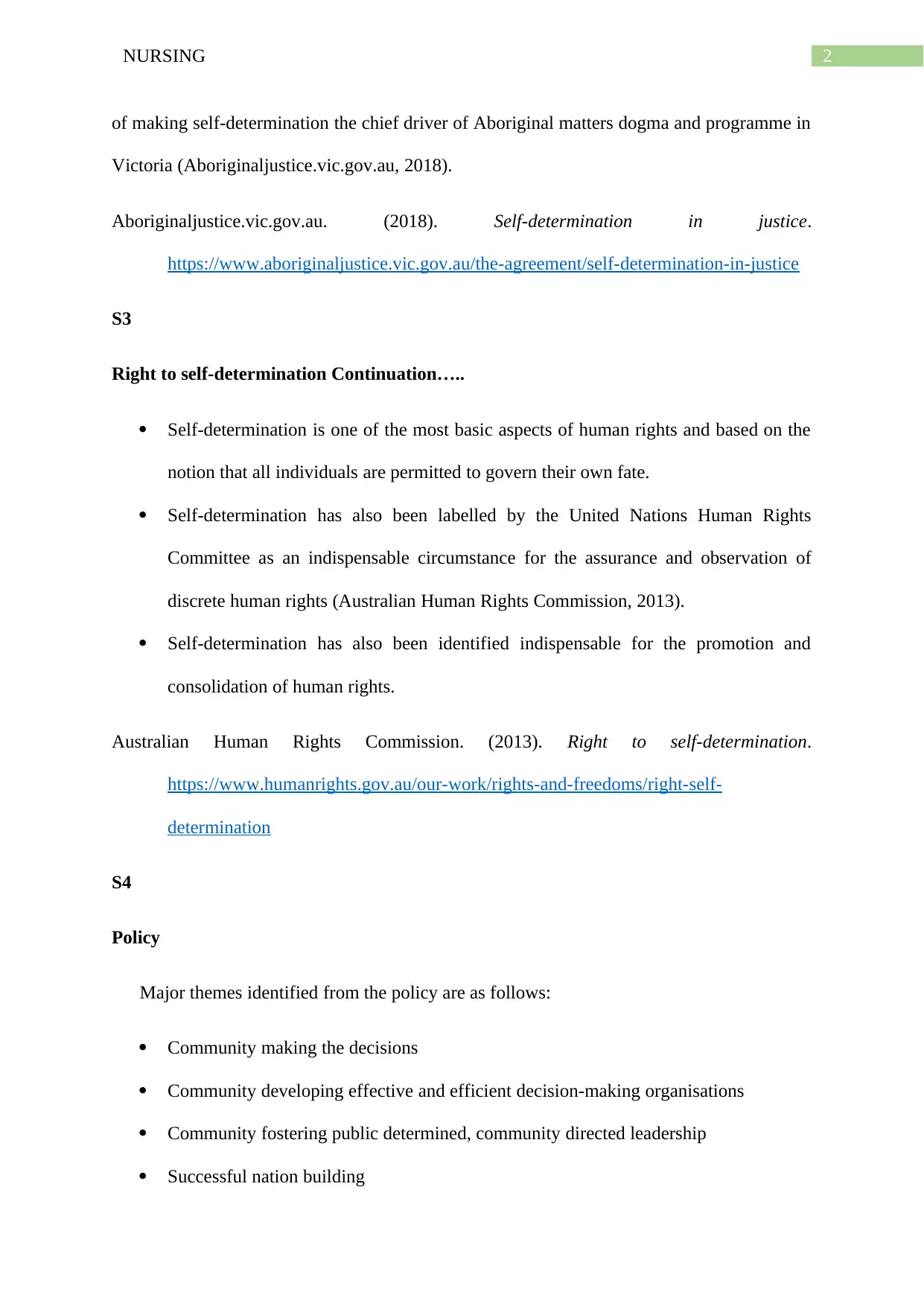
2NURSING
of making self-determination the chief driver of Aboriginal matters dogma and programme in
Victoria (Aboriginaljustice.vic.gov.au, 2018).
Aboriginaljustice.vic.gov.au. (2018). Self-determination in justice.
https://www.aboriginaljustice.vic.gov.au/the-agreement/self-determination-in-justice
S3
Right to self-determination Continuation…..
Self-determination is one of the most basic aspects of human rights and based on the
notion that all individuals are permitted to govern their own fate.
Self-determination has also been labelled by the United Nations Human Rights
Committee as an indispensable circumstance for the assurance and observation of
discrete human rights (Australian Human Rights Commission, 2013).
Self-determination has also been identified indispensable for the promotion and
consolidation of human rights.
Australian Human Rights Commission. (2013). Right to self-determination.
https://www.humanrights.gov.au/our-work/rights-and-freedoms/right-self-
determination
S4
Policy
Major themes identified from the policy are as follows:
Community making the decisions
Community developing effective and efficient decision-making organisations
Community fostering public determined, community directed leadership
Successful nation building
of making self-determination the chief driver of Aboriginal matters dogma and programme in
Victoria (Aboriginaljustice.vic.gov.au, 2018).
Aboriginaljustice.vic.gov.au. (2018). Self-determination in justice.
https://www.aboriginaljustice.vic.gov.au/the-agreement/self-determination-in-justice
S3
Right to self-determination Continuation…..
Self-determination is one of the most basic aspects of human rights and based on the
notion that all individuals are permitted to govern their own fate.
Self-determination has also been labelled by the United Nations Human Rights
Committee as an indispensable circumstance for the assurance and observation of
discrete human rights (Australian Human Rights Commission, 2013).
Self-determination has also been identified indispensable for the promotion and
consolidation of human rights.
Australian Human Rights Commission. (2013). Right to self-determination.
https://www.humanrights.gov.au/our-work/rights-and-freedoms/right-self-
determination
S4
Policy
Major themes identified from the policy are as follows:
Community making the decisions
Community developing effective and efficient decision-making organisations
Community fostering public determined, community directed leadership
Successful nation building
⊘ This is a preview!⊘
Do you want full access?
Subscribe today to unlock all pages.

Trusted by 1+ million students worldwide
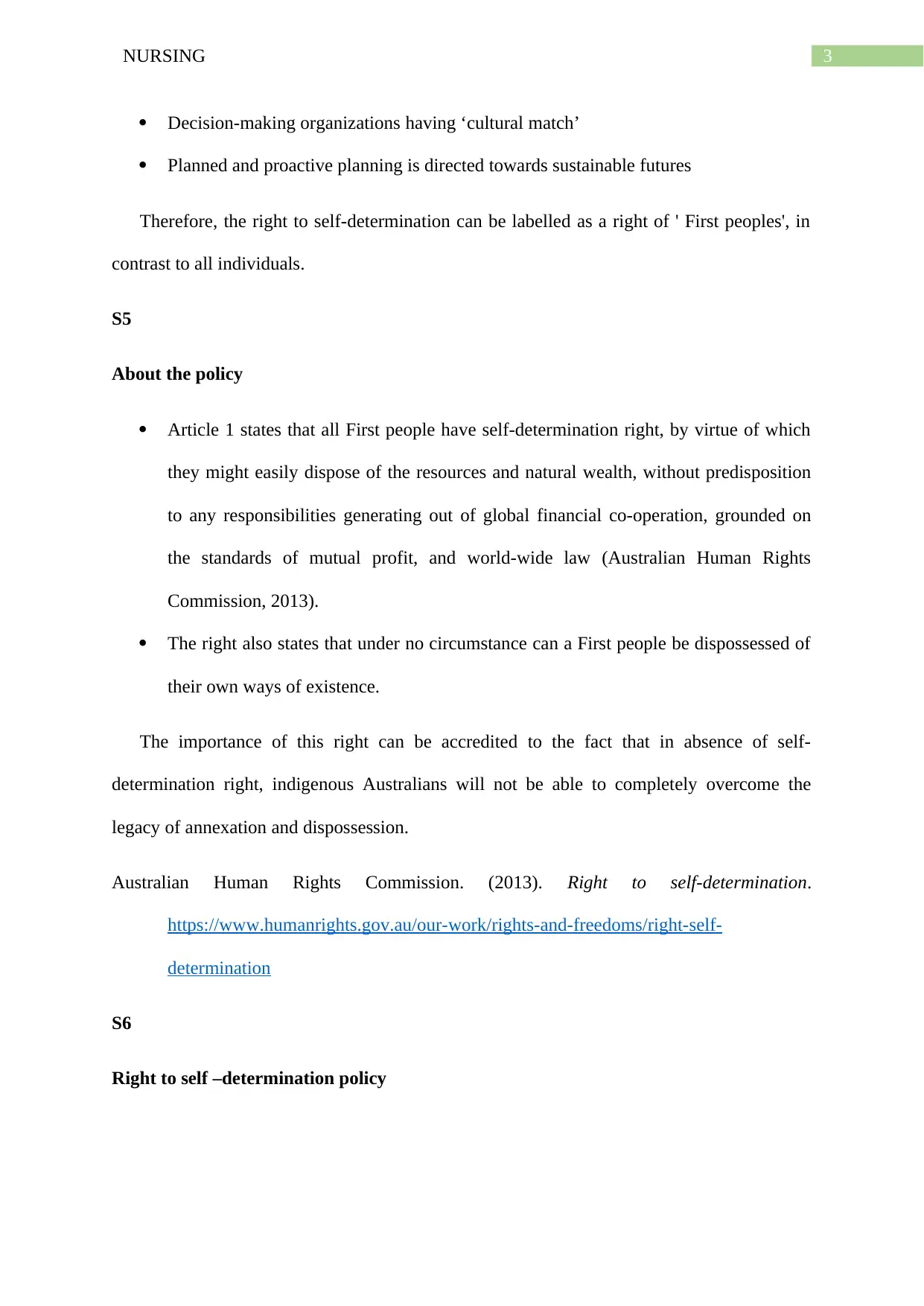
3NURSING
Decision-making organizations having ‘cultural match’
Planned and proactive planning is directed towards sustainable futures
Therefore, the right to self-determination can be labelled as a right of ' First peoples', in
contrast to all individuals.
S5
About the policy
Article 1 states that all First people have self-determination right, by virtue of which
they might easily dispose of the resources and natural wealth, without predisposition
to any responsibilities generating out of global financial co-operation, grounded on
the standards of mutual profit, and world-wide law (Australian Human Rights
Commission, 2013).
The right also states that under no circumstance can a First people be dispossessed of
their own ways of existence.
The importance of this right can be accredited to the fact that in absence of self-
determination right, indigenous Australians will not be able to completely overcome the
legacy of annexation and dispossession.
Australian Human Rights Commission. (2013). Right to self-determination.
https://www.humanrights.gov.au/our-work/rights-and-freedoms/right-self-
determination
S6
Right to self –determination policy
Decision-making organizations having ‘cultural match’
Planned and proactive planning is directed towards sustainable futures
Therefore, the right to self-determination can be labelled as a right of ' First peoples', in
contrast to all individuals.
S5
About the policy
Article 1 states that all First people have self-determination right, by virtue of which
they might easily dispose of the resources and natural wealth, without predisposition
to any responsibilities generating out of global financial co-operation, grounded on
the standards of mutual profit, and world-wide law (Australian Human Rights
Commission, 2013).
The right also states that under no circumstance can a First people be dispossessed of
their own ways of existence.
The importance of this right can be accredited to the fact that in absence of self-
determination right, indigenous Australians will not be able to completely overcome the
legacy of annexation and dispossession.
Australian Human Rights Commission. (2013). Right to self-determination.
https://www.humanrights.gov.au/our-work/rights-and-freedoms/right-self-
determination
S6
Right to self –determination policy
Paraphrase This Document
Need a fresh take? Get an instant paraphrase of this document with our AI Paraphraser
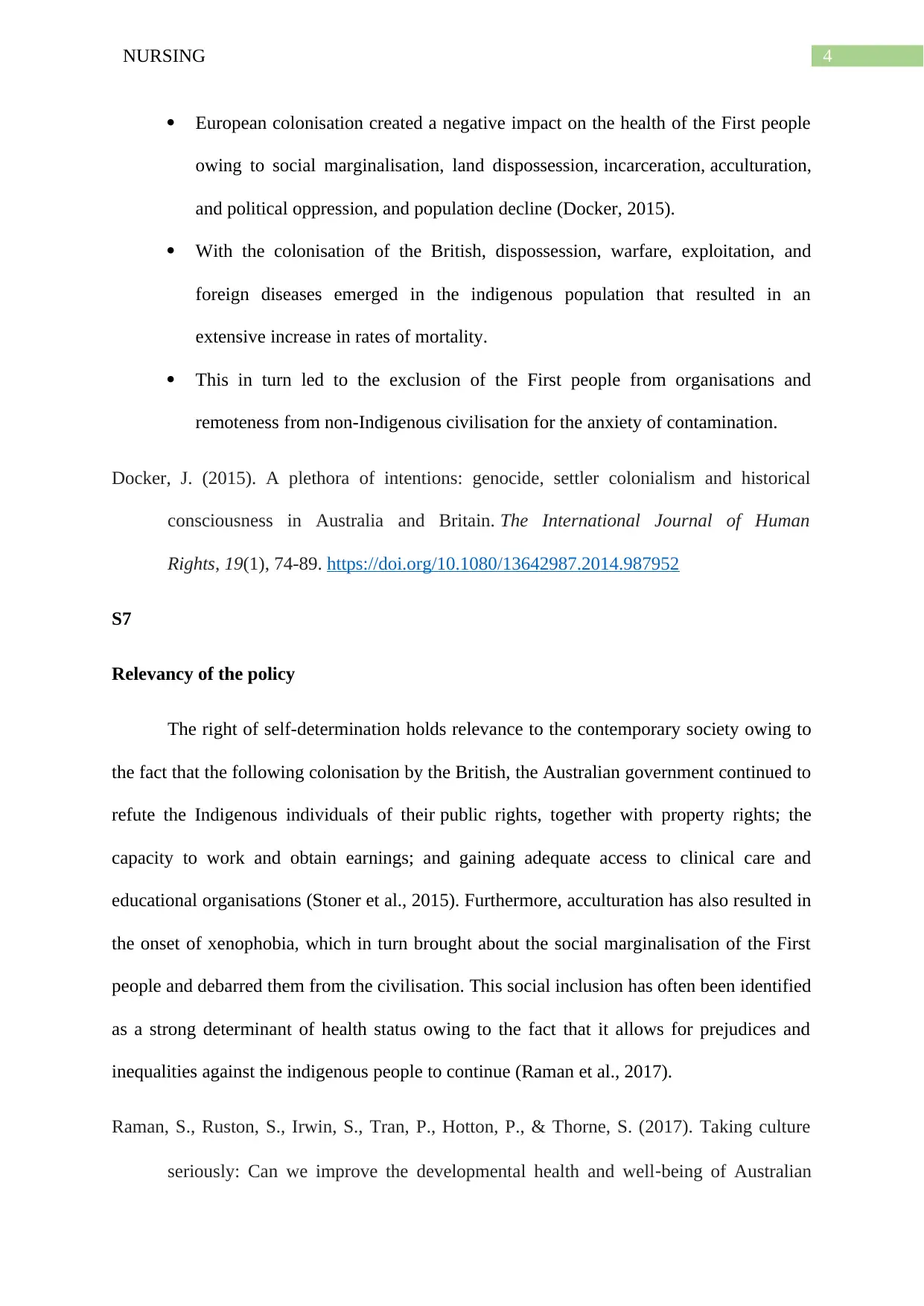
4NURSING
European colonisation created a negative impact on the health of the First people
owing to social marginalisation, land dispossession, incarceration, acculturation,
and political oppression, and population decline (Docker, 2015).
With the colonisation of the British, dispossession, warfare, exploitation, and
foreign diseases emerged in the indigenous population that resulted in an
extensive increase in rates of mortality.
This in turn led to the exclusion of the First people from organisations and
remoteness from non-Indigenous civilisation for the anxiety of contamination.
Docker, J. (2015). A plethora of intentions: genocide, settler colonialism and historical
consciousness in Australia and Britain. The International Journal of Human
Rights, 19(1), 74-89. https://doi.org/10.1080/13642987.2014.987952
S7
Relevancy of the policy
The right of self-determination holds relevance to the contemporary society owing to
the fact that the following colonisation by the British, the Australian government continued to
refute the Indigenous individuals of their public rights, together with property rights; the
capacity to work and obtain earnings; and gaining adequate access to clinical care and
educational organisations (Stoner et al., 2015). Furthermore, acculturation has also resulted in
the onset of xenophobia, which in turn brought about the social marginalisation of the First
people and debarred them from the civilisation. This social inclusion has often been identified
as a strong determinant of health status owing to the fact that it allows for prejudices and
inequalities against the indigenous people to continue (Raman et al., 2017).
Raman, S., Ruston, S., Irwin, S., Tran, P., Hotton, P., & Thorne, S. (2017). Taking culture
seriously: Can we improve the developmental health and well‐being of Australian
European colonisation created a negative impact on the health of the First people
owing to social marginalisation, land dispossession, incarceration, acculturation,
and political oppression, and population decline (Docker, 2015).
With the colonisation of the British, dispossession, warfare, exploitation, and
foreign diseases emerged in the indigenous population that resulted in an
extensive increase in rates of mortality.
This in turn led to the exclusion of the First people from organisations and
remoteness from non-Indigenous civilisation for the anxiety of contamination.
Docker, J. (2015). A plethora of intentions: genocide, settler colonialism and historical
consciousness in Australia and Britain. The International Journal of Human
Rights, 19(1), 74-89. https://doi.org/10.1080/13642987.2014.987952
S7
Relevancy of the policy
The right of self-determination holds relevance to the contemporary society owing to
the fact that the following colonisation by the British, the Australian government continued to
refute the Indigenous individuals of their public rights, together with property rights; the
capacity to work and obtain earnings; and gaining adequate access to clinical care and
educational organisations (Stoner et al., 2015). Furthermore, acculturation has also resulted in
the onset of xenophobia, which in turn brought about the social marginalisation of the First
people and debarred them from the civilisation. This social inclusion has often been identified
as a strong determinant of health status owing to the fact that it allows for prejudices and
inequalities against the indigenous people to continue (Raman et al., 2017).
Raman, S., Ruston, S., Irwin, S., Tran, P., Hotton, P., & Thorne, S. (2017). Taking culture
seriously: Can we improve the developmental health and well‐being of Australian
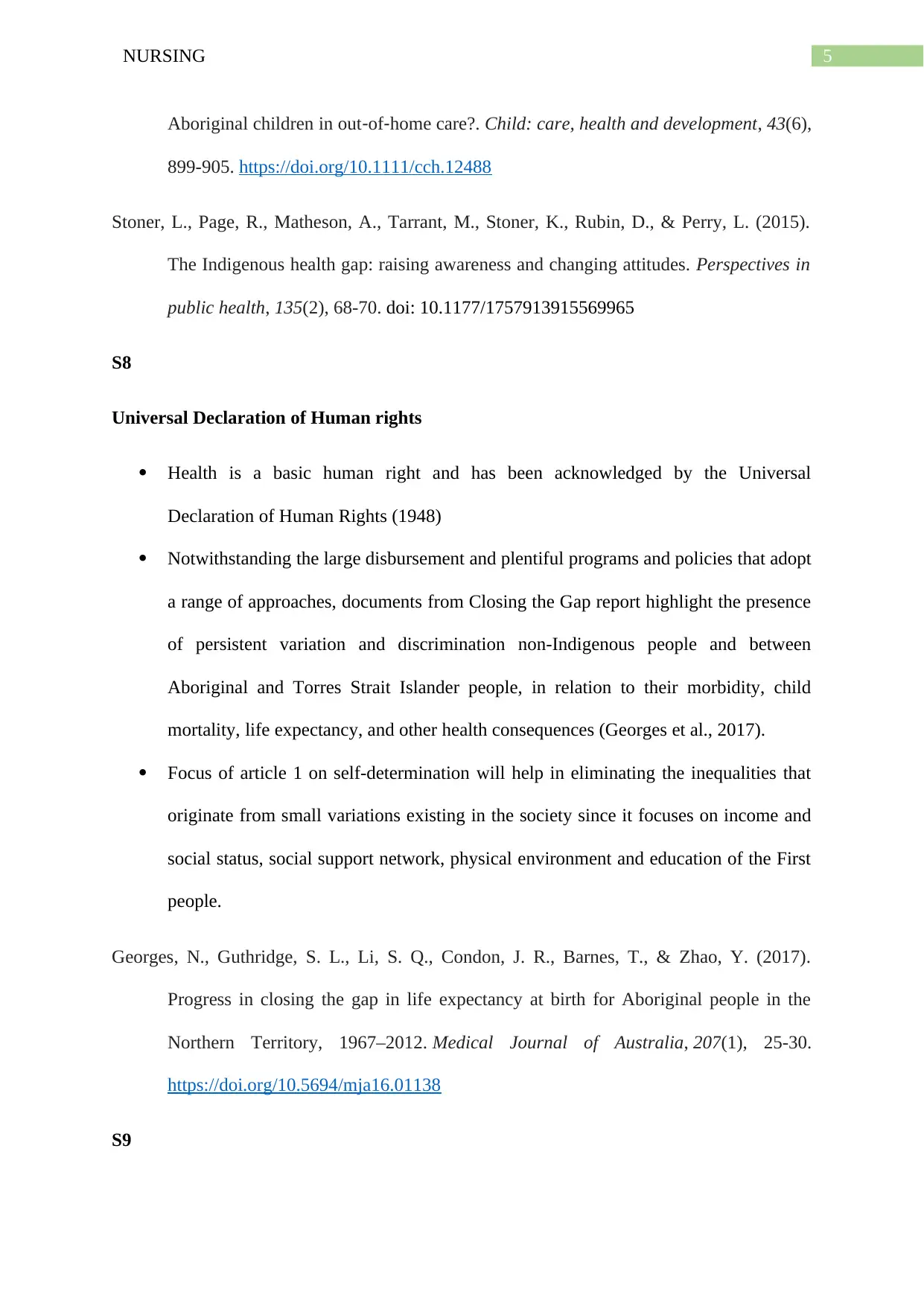
5NURSING
Aboriginal children in out‐of‐home care?. Child: care, health and development, 43(6),
899-905. https://doi.org/10.1111/cch.12488
Stoner, L., Page, R., Matheson, A., Tarrant, M., Stoner, K., Rubin, D., & Perry, L. (2015).
The Indigenous health gap: raising awareness and changing attitudes. Perspectives in
public health, 135(2), 68-70. doi: 10.1177/1757913915569965
S8
Universal Declaration of Human rights
Health is a basic human right and has been acknowledged by the Universal
Declaration of Human Rights (1948)
Notwithstanding the large disbursement and plentiful programs and policies that adopt
a range of approaches, documents from Closing the Gap report highlight the presence
of persistent variation and discrimination non-Indigenous people and between
Aboriginal and Torres Strait Islander people, in relation to their morbidity, child
mortality, life expectancy, and other health consequences (Georges et al., 2017).
Focus of article 1 on self-determination will help in eliminating the inequalities that
originate from small variations existing in the society since it focuses on income and
social status, social support network, physical environment and education of the First
people.
Georges, N., Guthridge, S. L., Li, S. Q., Condon, J. R., Barnes, T., & Zhao, Y. (2017).
Progress in closing the gap in life expectancy at birth for Aboriginal people in the
Northern Territory, 1967–2012. Medical Journal of Australia, 207(1), 25-30.
https://doi.org/10.5694/mja16.01138
S9
Aboriginal children in out‐of‐home care?. Child: care, health and development, 43(6),
899-905. https://doi.org/10.1111/cch.12488
Stoner, L., Page, R., Matheson, A., Tarrant, M., Stoner, K., Rubin, D., & Perry, L. (2015).
The Indigenous health gap: raising awareness and changing attitudes. Perspectives in
public health, 135(2), 68-70. doi: 10.1177/1757913915569965
S8
Universal Declaration of Human rights
Health is a basic human right and has been acknowledged by the Universal
Declaration of Human Rights (1948)
Notwithstanding the large disbursement and plentiful programs and policies that adopt
a range of approaches, documents from Closing the Gap report highlight the presence
of persistent variation and discrimination non-Indigenous people and between
Aboriginal and Torres Strait Islander people, in relation to their morbidity, child
mortality, life expectancy, and other health consequences (Georges et al., 2017).
Focus of article 1 on self-determination will help in eliminating the inequalities that
originate from small variations existing in the society since it focuses on income and
social status, social support network, physical environment and education of the First
people.
Georges, N., Guthridge, S. L., Li, S. Q., Condon, J. R., Barnes, T., & Zhao, Y. (2017).
Progress in closing the gap in life expectancy at birth for Aboriginal people in the
Northern Territory, 1967–2012. Medical Journal of Australia, 207(1), 25-30.
https://doi.org/10.5694/mja16.01138
S9
⊘ This is a preview!⊘
Do you want full access?
Subscribe today to unlock all pages.

Trusted by 1+ million students worldwide
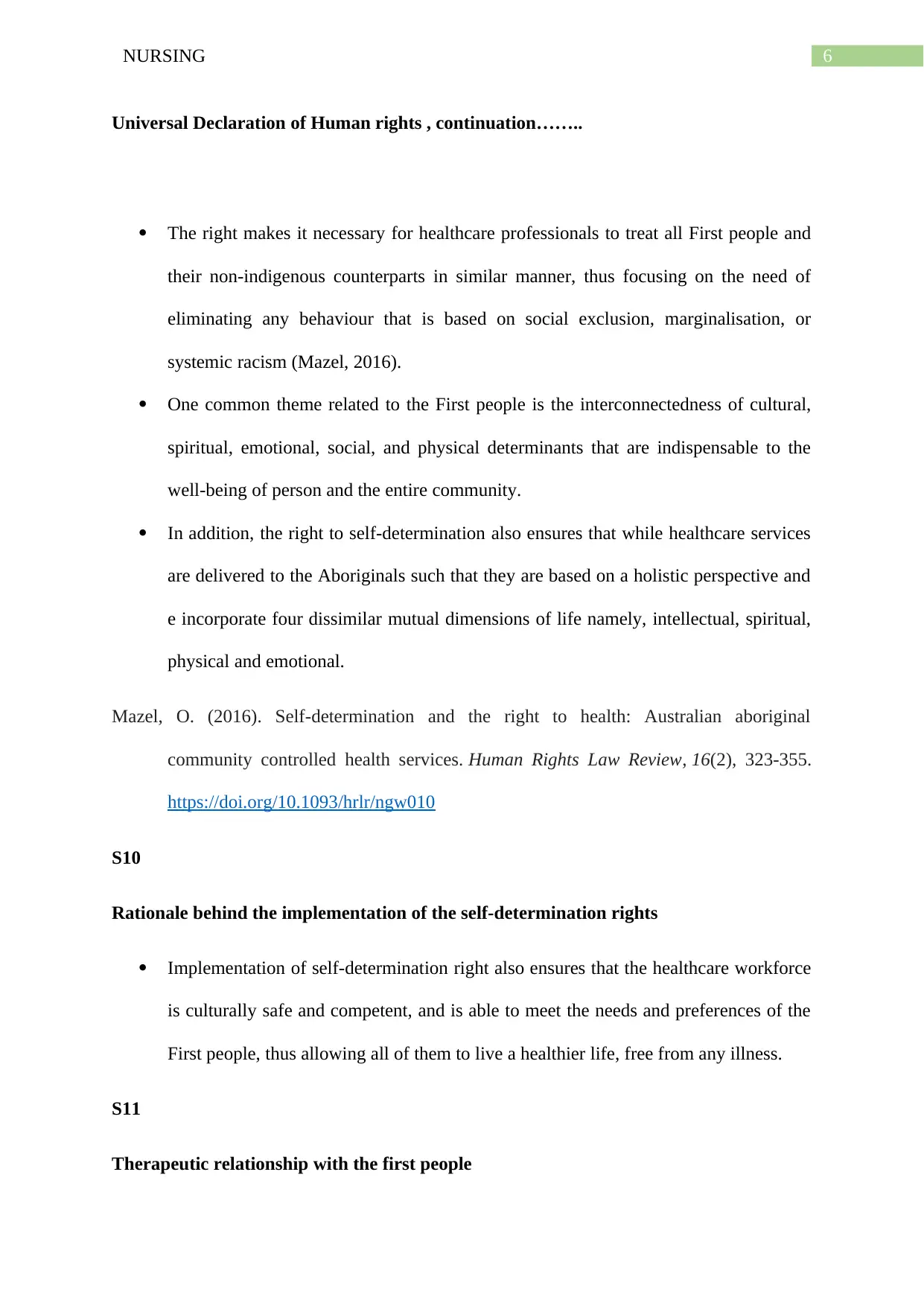
6NURSING
Universal Declaration of Human rights , continuation……..
The right makes it necessary for healthcare professionals to treat all First people and
their non-indigenous counterparts in similar manner, thus focusing on the need of
eliminating any behaviour that is based on social exclusion, marginalisation, or
systemic racism (Mazel, 2016).
One common theme related to the First people is the interconnectedness of cultural,
spiritual, emotional, social, and physical determinants that are indispensable to the
well-being of person and the entire community.
In addition, the right to self-determination also ensures that while healthcare services
are delivered to the Aboriginals such that they are based on a holistic perspective and
e incorporate four dissimilar mutual dimensions of life namely, intellectual, spiritual,
physical and emotional.
Mazel, O. (2016). Self-determination and the right to health: Australian aboriginal
community controlled health services. Human Rights Law Review, 16(2), 323-355.
https://doi.org/10.1093/hrlr/ngw010
S10
Rationale behind the implementation of the self-determination rights
Implementation of self-determination right also ensures that the healthcare workforce
is culturally safe and competent, and is able to meet the needs and preferences of the
First people, thus allowing all of them to live a healthier life, free from any illness.
S11
Therapeutic relationship with the first people
Universal Declaration of Human rights , continuation……..
The right makes it necessary for healthcare professionals to treat all First people and
their non-indigenous counterparts in similar manner, thus focusing on the need of
eliminating any behaviour that is based on social exclusion, marginalisation, or
systemic racism (Mazel, 2016).
One common theme related to the First people is the interconnectedness of cultural,
spiritual, emotional, social, and physical determinants that are indispensable to the
well-being of person and the entire community.
In addition, the right to self-determination also ensures that while healthcare services
are delivered to the Aboriginals such that they are based on a holistic perspective and
e incorporate four dissimilar mutual dimensions of life namely, intellectual, spiritual,
physical and emotional.
Mazel, O. (2016). Self-determination and the right to health: Australian aboriginal
community controlled health services. Human Rights Law Review, 16(2), 323-355.
https://doi.org/10.1093/hrlr/ngw010
S10
Rationale behind the implementation of the self-determination rights
Implementation of self-determination right also ensures that the healthcare workforce
is culturally safe and competent, and is able to meet the needs and preferences of the
First people, thus allowing all of them to live a healthier life, free from any illness.
S11
Therapeutic relationship with the first people
Paraphrase This Document
Need a fresh take? Get an instant paraphrase of this document with our AI Paraphraser
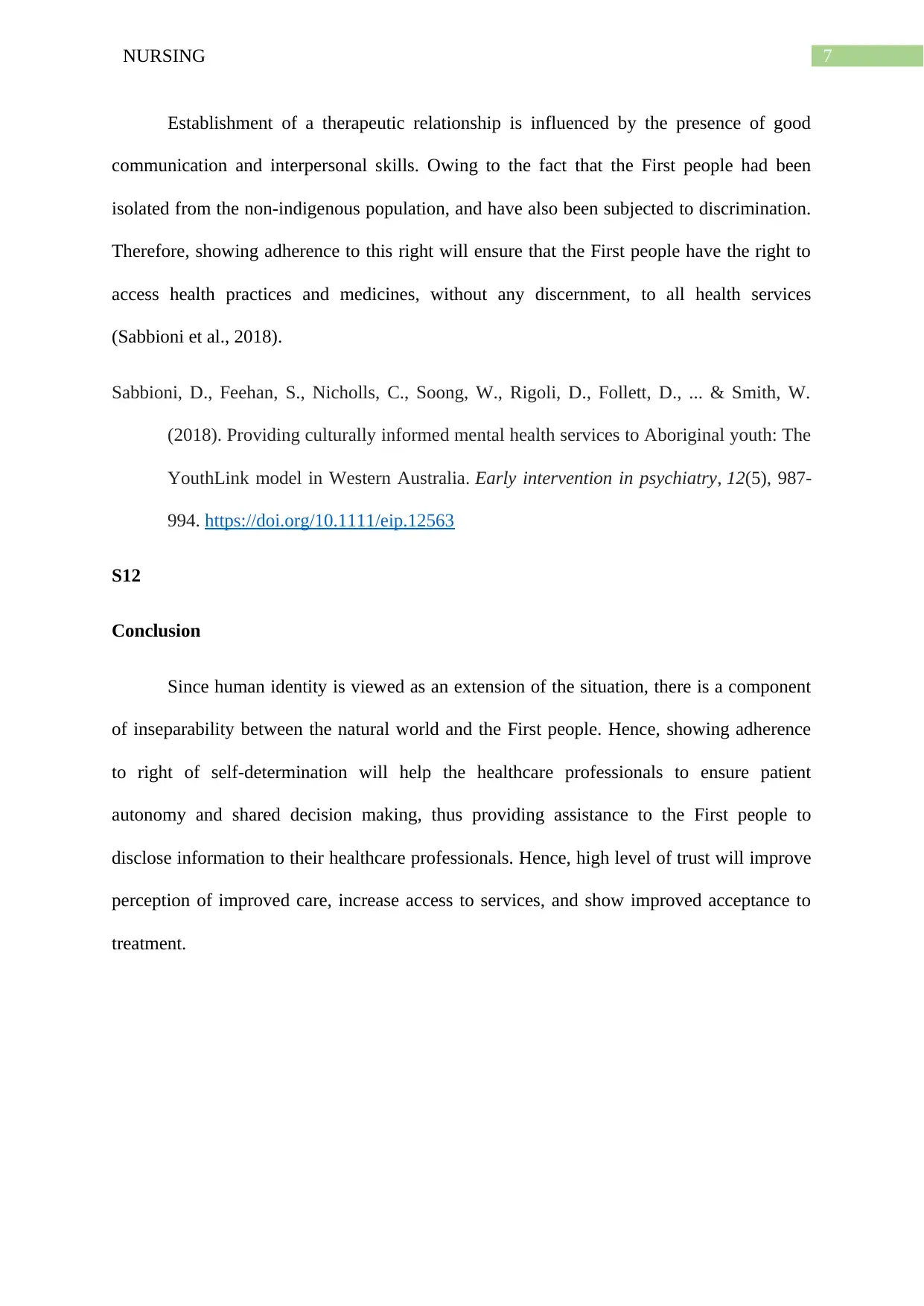
7NURSING
Establishment of a therapeutic relationship is influenced by the presence of good
communication and interpersonal skills. Owing to the fact that the First people had been
isolated from the non-indigenous population, and have also been subjected to discrimination.
Therefore, showing adherence to this right will ensure that the First people have the right to
access health practices and medicines, without any discernment, to all health services
(Sabbioni et al., 2018).
Sabbioni, D., Feehan, S., Nicholls, C., Soong, W., Rigoli, D., Follett, D., ... & Smith, W.
(2018). Providing culturally informed mental health services to Aboriginal youth: The
YouthLink model in Western Australia. Early intervention in psychiatry, 12(5), 987-
994. https://doi.org/10.1111/eip.12563
S12
Conclusion
Since human identity is viewed as an extension of the situation, there is a component
of inseparability between the natural world and the First people. Hence, showing adherence
to right of self-determination will help the healthcare professionals to ensure patient
autonomy and shared decision making, thus providing assistance to the First people to
disclose information to their healthcare professionals. Hence, high level of trust will improve
perception of improved care, increase access to services, and show improved acceptance to
treatment.
Establishment of a therapeutic relationship is influenced by the presence of good
communication and interpersonal skills. Owing to the fact that the First people had been
isolated from the non-indigenous population, and have also been subjected to discrimination.
Therefore, showing adherence to this right will ensure that the First people have the right to
access health practices and medicines, without any discernment, to all health services
(Sabbioni et al., 2018).
Sabbioni, D., Feehan, S., Nicholls, C., Soong, W., Rigoli, D., Follett, D., ... & Smith, W.
(2018). Providing culturally informed mental health services to Aboriginal youth: The
YouthLink model in Western Australia. Early intervention in psychiatry, 12(5), 987-
994. https://doi.org/10.1111/eip.12563
S12
Conclusion
Since human identity is viewed as an extension of the situation, there is a component
of inseparability between the natural world and the First people. Hence, showing adherence
to right of self-determination will help the healthcare professionals to ensure patient
autonomy and shared decision making, thus providing assistance to the First people to
disclose information to their healthcare professionals. Hence, high level of trust will improve
perception of improved care, increase access to services, and show improved acceptance to
treatment.
1 out of 8
Related Documents
Your All-in-One AI-Powered Toolkit for Academic Success.
+13062052269
info@desklib.com
Available 24*7 on WhatsApp / Email
![[object Object]](/_next/static/media/star-bottom.7253800d.svg)
Unlock your academic potential
Copyright © 2020–2025 A2Z Services. All Rights Reserved. Developed and managed by ZUCOL.





